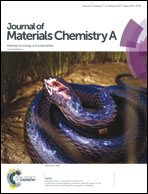High-performance urea electrolysis towards less energy-intensive electrochemical hydrogen production using a bifunctional catalyst electrode†
Abstract
It is highly desirable but still remains a big challenge to develop earth-abundant bifunctional catalysts for urea oxidation and hydrogen evolution electrocatalysis towards more energy-efficient electrolytic hydrogen generation. In this study, we report that nickel phosphide nanoflake arrays on carbon cloth (Ni2P NF/CC) behave as a highly-active durable 3D catalyst electrode for the urea oxidation reaction (UOR) with the required potential of 0.447 V to achieve a geometrical catalytic current density of 100 mA cm−2 in a 1.0 M KOH with 0.5 M urea. Remarkably, the high hydrogen evolution reaction (HER) activity of Ni2P NF/CC enables it to be a bifunctional catalyst for both the UOR and HER towards energy-saving electrochemical hydrogen production, and its two-electrode alkaline electrolyzer requires a cell voltage of only 1.35 V to attain 50 mA cm−2, which is 0.58 V less compared with that required for pure water splitting to achieve the same current density, with remarkable long-term electrochemical durability and nearly 100% Faradaic efficiency for hydrogen evolution.

- This article is part of the themed collection: JMC A Editor’s choice collection: Recent advances in solar fuels and photocatalysis research


 Please wait while we load your content...
Please wait while we load your content...